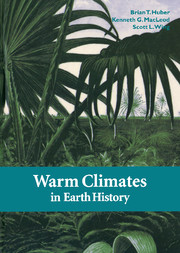Book contents
- Frontmatter
- Contents
- List of contributors
- Preface
- Part 1 Approaches to the study of paleoclimates
- Part II Case studies: latest Paleocene–early Eocene
- Part III Case studies: Mesozoic
- Part IV Case studies: Paleozoic
- 11 Permian and Triassic high latitude paleoclimates: evidence from fossil biotas
- 12 Organic carbon burial and faunal dynamics in the Appalachian Basin during the Devonian (Givetian–Famennian) greenhouse: an integrated paleoecological and biogeochemical approach
- 13 Glaciation in the early Paleozoic ‘greenhouse’: the roles of paleogeography and atmospheric CO2
- Part V Overview: climate across tectonic timescales
- Index
- Plate section
11 - Permian and Triassic high latitude paleoclimates: evidence from fossil biotas
from Part IV - Case studies: Paleozoic
Published online by Cambridge University Press: 06 July 2010
- Frontmatter
- Contents
- List of contributors
- Preface
- Part 1 Approaches to the study of paleoclimates
- Part II Case studies: latest Paleocene–early Eocene
- Part III Case studies: Mesozoic
- Part IV Case studies: Paleozoic
- 11 Permian and Triassic high latitude paleoclimates: evidence from fossil biotas
- 12 Organic carbon burial and faunal dynamics in the Appalachian Basin during the Devonian (Givetian–Famennian) greenhouse: an integrated paleoecological and biogeochemical approach
- 13 Glaciation in the early Paleozoic ‘greenhouse’: the roles of paleogeography and atmospheric CO2
- Part V Overview: climate across tectonic timescales
- Index
- Plate section
Summary
ABSTRACT
High latitude fossil floras provide an important source of data on past climates, since the plants were living in a strongly seasonal light regime and often existed at the limit of their environmental tolerances. Permian and Triassic rocks from Antarctica have been a rich source of biological information because of the large number of sites that have yielded exquisitely preserved fossil plants. Anatomically preserved plants from several sites in the central Transantarctic Mountains and southern Victoria Land provide a unique source of fossil tree ring data. Samples of wood have come from a variety of sites including fluvial settings, permineralized peat deposits, and forest sites where the trees are preserved in situ (in growth position). The wood exhibits distinct growth rings which have been analyzed for paleoclimate signals. Rings from both Permian and Triassic woods are large, ranging from a few millimeters to several centimeters in width, and represent growth rates that are 1–2 orders of magnitude larger than those at high latitudes today. In addition, the structure of the individual rings differs from that seen in modern temperate rings. The presence of a considerable amount of early wood and only 1–2 cells of latewood suggests that light may have been the limiting factor in the growth of these forest trees. Tree ring data, as well as the level of diversity in the Antarctic Permian and Triassic floras are at variance with the majority of paleoclimate models that have been produced for the region.
- Type
- Chapter
- Information
- Warm Climates in Earth History , pp. 321 - 350Publisher: Cambridge University PressPrint publication year: 1999
- 4
- Cited by

